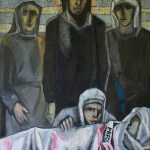
March 19 – 27 2019 / Building 5/ Dubai Design District
Curators: Rula Alami and Nadine Khoury
In the wake of the study of modern Arab culture and the development of visual arts in the Middle East, Palestinian art is being (re)discovered and given back its legitimacy as a full-fledged culture. The challenge is high and the writing of Palestinian art history is intricate. Where on the one hand, there is a lack of written materials inherent to the oral culture preeminent in the Middle East, and on the other the Israeli-Palestinian conflict that can only taint politically the writing of Palestinian art history. This subject has been wonderfully analyzed by Kamal Boullata, who gives a great insight of the construction of Palestinian culture and identity before 1948 (the Nakba) and the evolution that followed. Moreover Boullata touches on the emergence of visual arts as a recognized form of art in a region where music and literature were dominant (Palestinian art, from 1850 to the Present, 2009).
After the Nakba in 1948, the majority of native Palestinians were dispersed, uprooted or exiled; as a result, their common history was fragmented between Al Dakhel Palestinians and the Diaspora. Consequently, Palestinian artists today are scattered, but a group still lives in their native homeland: the Al Dakhel (from the inside) artists.
These artists, who stayed -or could come back to their homes after 1948, had to grow up in a system where their culture and immediate past was
erased and any relationship with the Palestinian diaspora was difficult. Their cultural education was unique in the region, reflecting the influences from western and eastern Europe as a result of the diversity of the newly emigrated people. It slowly changed after the 1970s, when the second generation “post Nakba” started to explore their own roots and question their status in society. In parallel, artists such as Abed Abdi and Asad Azi, were working on the reconstruction of a local Palestinian collective memory. Today, the identity of Al Dakhel artists is stretched between citizenship, Israeli education, occidental influences, their belonging to Palestinian culture and their strong attachment to their land.
Questions related to displacement, belonging, native culture and fragmentation are recurring. By working on these personal and acute questions in a complex society, they touch a universal question: who are we and how does identity evolve when challenged? Belonging explores the artistic (re)construction of the Al Dakhel identity and its evolution through three generations of artists.
ARTISTS
Abed Abdi Abed Abdi (1942) was born into a long standing Haifa family. In April 1948, Abed Abdi, his mother and siblings were uprooted from their home, while his father remained in Haifa. After three years of wandering between Palestinian refugee camps in Lebanon and Syria, they were allowed back into Israel as part of the family reunification program. Abdi learned painting and sculpting at the workshops of Israeli art teachers. In 1962, Abdi was accepted for membership in the Haifa branch of the Israeli Association of Painters and Sculptors, becoming its first Arab member. Abdi then pursued academic studies at the Fine Arts Academy in Dresden (Germany) with Lea Grundig. His broad artistic range encompasses painting, graphic design, monuments and illustrations. Abdi has been a pillar of the development of Al Dakhel contemporary art and the creation of a new collective memory within his community through the building of memorial monuments and the circulation of prints through newspapers. In 1994, Abdi set up the IBDA association for deepening the dialogue between Arabs and Jews through Arts, and was one of the Founding Members of the Khalil Sakakini Cultural Center in Ramallah in 1998. He has received numerous awards and has exhibited extensively in Europe and Israel. He currently lives in Haifa.
Abed Abdi has been promoting Palestinian culture, intercultural exchange and peace through art for more than three decades. As he explains, “art must be committed and play a role.” Deeply influenced by his art education in Eastern Germany, Abdi is also one of the first artists to integrate western influences and techniques within his work. He began as a figurative painter and later evolved towards abstraction. His works may seem calm at first, almost muted. However, the use of concrete and rough textures, mixed with fragments of everyday objects, conveys a strong view about his people and his culture. The works in this exhibition feature use of mixed media, culturally charged iconography, and themes related to his experience as a refugee, including spirituality, Palestinian culture and women. In the 1990s, fragments of jute bags, carpets, jewels, glass, and other materials became recurrent in his works, used as a way to tell stories of broken lives. The jute bag is omnipresent: the UNRWA distributes them in refugee camps. Resources being scarce, the bags are often recycled, becoming carpets, tents, and other everyday objects. Seen from this perspective, they are a symbol for the tragedy of Palestinian refugees.




















